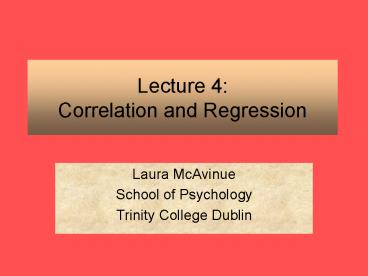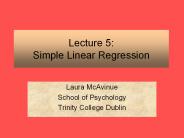Lecture 4: Correlation and Regression - PowerPoint PPT Presentation
1 / 34
Title:
Lecture 4: Correlation and Regression
Description:
Lecture 4: Correlation and Regression Laura McAvinue School of Psychology Trinity College Dublin Correlation Relationship between two variables Do two variables co ... – PowerPoint PPT presentation
Number of Views:554
Avg rating:3.0/5.0
Title: Lecture 4: Correlation and Regression
1
Lecture 4Correlation and Regression
- Laura McAvinue
- School of Psychology
- Trinity College Dublin
2
Correlation
- Relationship between two variables
- Do two variables co-vary / co-relate?
- Is mathematical ability related to IQ?
- Are depression and anxiety related?
- Does variable Y vary as a function of variable X?
- Does error awareness vary as a function of
ability to sustain attention? - Does accuracy of memory decline with age?
3
Correlation
- Direction
- Do both variables move in the same direction?
- Do they move in opposite directions?
- Degree
- What is the degree or strength of the
relationship? - Analysis
- Scatterplot
- Correlation Coefficient
- Statistical significance
4
Scatterplot
- Describe the relationship between the two
variables using a scatterplot - Visual representation of the relationship between
the variables - Plot each observation in the study, displaying
its value on variable X and variable Y - Place the predictor variable on the X axis
- The independent variable, which is making the
prediction - Place the criterion variable on the Y axis
- The dependent variable, which is being predicted
5
- Participant Anxiety Depression
- 1 1
- 3 3
- 6 6
?
?
?
?
?
?
6
No Relationship
Random Scatter
7
Positive Relationship
Direction in scatter
8
Negative Relationship
Direction in Scatter
9
Sometimes, the direction of the relationship
might not be as obvious
What is the relationship between verbal coherence
and the number of pints of beer consumed?
10
Regression Line
- Useful to add a regression line
- Model of the relationship
- Straight line that best represents the
relationship between the two variables - The line of best fit
- Helps us to understand the direction of the
relationship
11
Adding the regression line helps us see the
direction of the relationship
12
Direction of Relationship
- Positive
- Two variables tend to move in the same direction
- As X increases, Y also increases
- As X decreases, Y also decreases
- Negative
- Two variables tend to move in opposite directions
- As X increases, Y decreases
- As X decreases, Y increases
13
A Positive Relationship
14
A Negative Relationship
15
Degree of Relationship
- Degree or strength of relationship
- Calculate a correlation coefficient
- Pearson Product-Moment Correlation Coefficient
(r) - Statistic that varies between -1 and 1
- r 0, no relationship between the variables
- Change in X is not associated with systematic
change in Y - r 1, perfect positive correlation
- Increase in X associated with systematic increase
in Y - r -1, perfect negative correlation
- Increase in X associated with systematic decrease
in Y
16
Interpretation of r
- Perfect
- Negative
- relationship
Perfect Positive relationship
-1 0 1
Absolutely No relationship
Closer Pearson r is to one of the extremes, the
stronger the relationship between the variables
17
Calculation of Pearson r
- Based on the covariance
- A statistic representing the degree to which two
variables vary together - Based on how an observation deviates from the
mean on each variable
18
Calculation of Pearson r
- Covariance is not suitable as measure of degree
of relationship - Absolute value is a function of standard
deviations - Scale the covariance by the standard deviations
- Pearson r
19
Assessing Magnitude of r
- Cohens (1988) standards
- Small Medium Large
- .1 - .29 .3 - .49 .5 - 1
- Statistical Significance
- Test the null hypothesis that the true
correlation in the population (rho) is zero - Ho ? 0
- Calculate the probability of obtaining a
correlation of this size if the true correlation
is zero - If p lt .05, reject Ho and conclude that it is
unlikely that the results are due to chance, the
correlation obtained represents a true
correlation in the population
20
Summary
- Interested in the relationship between two
variables - Direction and degree of relationship
- Scatterplot regression line
- Direction
- Correlation Coefficient
- Magnitude
- Statistical significance
21
As temperature increases, ice-cream consumption
increases
r .73 (large) n 12 p .007
22
As temperature increases, hot whiskey consumption
decreases
r -.908 (large) n 12 p lt.001
23
Issues to consider
- Assumption of linearity
- Pearson correlation assumes there is a linear
relationship between the two variables - Assumes the relationship can be represented by a
straight line - It is possible that the relationship might be
better represented by a curved line - Examine scatterplot
- Curve-fitting procedures
24
Linear?
25
Non-linear?
26
Non-linear
27
Issues to consider
- Correlation can be affected by
- Range restrictions
- Heterogeneous subsamples
- Extreme observations
- Correlation does not mean causation
28
Regression
- The regression line
- A straight line that represents the relationship
between two variables - Useful to add to the scatterplot to help us see
the direction of the relationship - But its much more than this
- Prediction
- Regression line enables us to predict Variable Y
on the basis of Variable X
29
Regression
- If you have an equation of the line that
represents the relationship between Variables X
Y, you can use it to predict a value of Y given a
certain value of X.
Y 45
X 63
30
Regression Equation
Regression Coefficients
Predicted value of Y
Predicting value of X
The basic equation of a line
31
Regression Equation
- b
- The slope of the regression line
- The amount of change in Y associated with a
one-unit change in X - a
- The intercept
- The point where the regression line crosses the Y
axis - The predicted value of Y when X 0
32
Regression Equation
Y
b
a
X
33
Same intercept, different slopes
Same slope, different intercepts
34
Summary
- The relationship between two variables, X Y
- Correlation
- Degree and direction of relationship
- Regression
- Predict Y, given X
- More on regression next lecture































